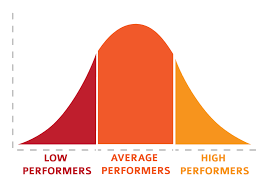Consultants, like me, market researchers, and technology vendors love normal distribution charts. They are a, sometimes, useful way to look at performance or data on large groups and data sets.
For example, when we look at very large organizations, let’s say 1000 sales people. Inevitably, we find the data distribution along virtually every aspect of performance looks like a normal distribution chart. A small number of top performers on one side doing top performance, a small number of poor performers doing their thing, and the majority falling somewhere in between.
And we draw all sorts of conclusions from these normal distribution charts. For example, one of the favorite pieces of analysis is the question, “What if we could improve performance 10-15%, who should we be focusing on?” And we do the analysis to that supports the argument we want to make.
In some ways, it’s playing games with data, but occasionally, it’s somewhat useful. For example, sales enablement or sales ops looking at how to drive performance improvements across the whole organization.
But this theory of large numbers is often misleading. For example, too many make the argument, “If we coach the middle and raise performance by 15% the performance improvement is tremendous….” They are correct, the math works out.
Pragmatically, this isn’t very pragmatic…..
Think about it, the average span of control of a manager is currently about 8 people (I saw a normal distribution chart on this). What the “theory” of large numbers would tell you is to focus on the 4 people in the middle, spending less time with the two top performers and the two bottom performers.
You can see how the argument works at a large organizational level, but quickly falls apart as we look at managers working with their small teams of people.
There is no reason why the manager shouldn’t focus on raising the performance of all 8 of their people! We can’t afford to have poor performers, we want to improve the performance of those two people, or get them into different roles. Likewise, we want to work with our two top performers, helping them improve. And, of course we work with the 4 in the middle.
Our sales teams are relatively small, as managers, our jobs are to maximize the performance of each person on our team, not focusing on meaningless mathematical models that only work with large numbers.
Imagine how we change those “large numbers” if each manager, at all levels, focused on helping their direct reports maximize their performance.
Maybe we can change the notion of what is “normal.”

Leave a Reply